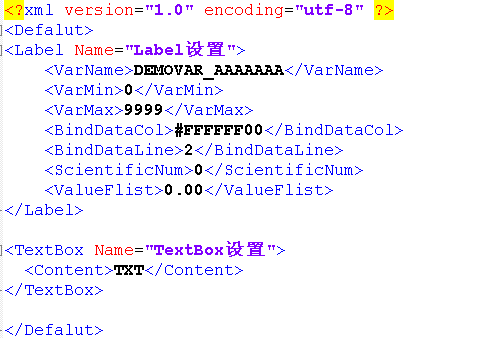/// <summary> /// 创建一个xml文件/// </summary> /// 根节点<local svduver="2.0"> /// <param name="filepath">文件路径</param> public static void CreateFileSaveLocal(string filepath) { XmlDocument xmlDoc = new XmlDocument(); //创建类型声明节点 XmlNode node = xmlDoc.CreateXmlDeclaration("1.0", "UTF-8", ""); xmlDoc.AppendChild(node); //创建根节点 local节点带属性值svduver="2.0" XmlNode root = xmlDoc.CreateElement("local"); xmlDoc.AppendChild(root); // 添加节点属性 XmlNode attrCount = xmlDoc.CreateNode(XmlNodeType.Attribute, "svduver", null); attrCount.Value = "2.0"; root.Attributes.SetNamedItem(attrCount);
XmlNode attrMeg = xmlDoc.CreateNode(XmlNodeType.Attribute, "describe", null); attrMeg.Value = "带属性值的节点"; root.Attributes.SetNamedItem(attrMeg); //XmlElement root = xmlDoc.CreateElement(Node_Local); //root.SetAttribute("svduver", "2.0"); //xmlDoc.AppendChild(root); //保存创建的XML文件 xmlDoc.Save(filepath); }
写入xml文件
上图代码创建的xml文件格式如下图:上图只创建了根节点

/// <summary> /// 将设置的变量数据写入xml文件中/// </summary> /// <param name="filepath">文件路径</param> /// <param name="varName">变量名称</param> /// <param name="varType">变量类型</param> /// <param name="varINI">上电初始值</param> /// <param name="varYes">有效值</param> /// <param name="varMeg">描述</param> public static void WriteLocalVariableToXml(string filepath, List<string> varName, List<string> varType, List<string> varINI, List<string> varYes, List<string> varMeg) { if (File.Exists(filepath)) { XmlDocument xmldoc = new XmlDocument(); xmldoc.Load(filepath); XmlNode rootNode = xmldoc.SelectSingleNode("local");//XML文档根节点 //rootNode.RemoveAll(); for (int i = 0; i < varName.Count; i++) { XmlElement element1 = xmldoc.CreateElement("Variable"); element1.SetAttribute("Name", varName[i]); element1.SetAttribute("Type", varType[i]); element1.SetAttribute("Val", varYes[i]); element1.SetAttribute("Ini", varINI[i]); element1.SetAttribute("Meg", varMeg[i]); rootNode.AppendChild(element1); } xmldoc.Save(filepath); } }
如果是标准的XML (如下图),读取就方便的多:
创建标准的xml:
public static void CreateDefaultLocal(string filepath) { XmlDocument xmlDoc = new XmlDocument(); //创建类型声明节点 XmlNode node = xmlDoc.CreateXmlDeclaration("1.0", "UTF-8", ""); xmlDoc.AppendChild(node); //创建根节点 XmlNode root = xmlDoc.CreateElement("Defalut"); xmlDoc.AppendChild(root); //根节点下创建TextBox节点 XmlNode tb = xmlDoc.CreateElement("TextBox"); root.AppendChild(tb); // 添加节点属性 XmlNode attrCount2 = xmlDoc.CreateNode(XmlNodeType.Attribute, "Name", null); attrCount2.InnerText = "文本框默认值设置"; tb.Attributes.SetNamedItem(attrCount2); XmlNode tb_con = xmlDoc.CreateNode(XmlNodeType.Element, "Content", null); tb_con.InnerText = "TXT";//这两句是跟上面最主要的区别,这里是创建节点,并且是:XmlNodeType.Element类型
tb.AppendChild(tb_con); //保存创建的XML文件 xmlDoc.Save(filepath);
}

/// <summary> /// 从XML文件获取数据 /// </summary> /// <param name="spath">Xml文件路径</param> /// <param name="nodeName">要读取的节点</param> /// <returns>返回节点下的所有子节点数据DataTable</returns> public static DataTable ReadDefaultXml(string spath, string nodeName) { try { DataSet ds = new DataSet(); if (File.Exists(spath)) { ds.ReadXml(spath); } return ds.Tables[nodeName]; } catch (Exception ex) { //throw ex; return null; } }
以上的方法,直接调用:ReadDefaultXml(“Defa.xml”,"Label");//读取Label节点下的子节点。